Wireless Security Camera Buying Guide for Beginners
Wireless security cameras allow homeowners to secure their property without requiring complicated installation. They provide versatility, intelligent features, and peace of mind, whether you want to monitor your front entrance, lawn, or living room. However, not all cameras function the same way, and with so many possibilities, selecting the ideal one may be intimidating. This article lays down the key characteristics to consider before purchasing, including video quality, storage capacity, and power options. You'll also discover how to choose the best kind for your house, making the selection easier and assuring long-term happiness with your investment.

Key Features to Consider Before Buying a Wireless Security Camera
Video Quality
Clear video clarity allows you to detect faces, license plates, and suspicious activities. Many entry-level cameras have 1080p resolution, which is suitable for general monitoring. If you want more details, particularly in outdoor environments, consider 2K or 4K alternatives. Frame rate is also important; a camera with at least 30 frames per second catches smoother movements. Low-light performance is crucial, so look for infrared or color night vision options. Wide-angle lenses provide greater coverage, minimizing blind spots. When evaluating devices, consider resolution against storage requirements, since higher-quality films need more space in both cloud and local storage.
Battery Life and Power Options
Wireless cameras use rechargeable batteries or constant electricity from outlets or solar panels. Battery-powered devices are easy to install because they do not require wiring, but you will need to recharge them every few weeks or months, depending on use. Models with solar panel attachments or direct power connections are ideal for low-maintenance operation. Placement also has an impact: outdoor devices may deplete batteries faster owing to frequent motion triggers, whereas inside units often last longer. Look for cameras with battery-saving settings, such as activity-based recording, to help extend life. Always match power options to your preferences and configuration.
Cloud Storage and Local Storage Options
Storage controls how you may access and save video recordings. Cloud storage allows you to access footage remotely via an app and frequently includes features such as smart notifications and video sharing. However, most services charge a monthly price and have a time restriction for keeping recordings. Local storage, such as microSD cards or external drives, stores video without incurring continuing charges, although access may be limited when you are gone. Hybrid alternatives, which combine cloud and local storage, give flexibility and backup security. When selecting a camera, consider storage space, subscription cost, and whether it offers encrypted storage to protect your data from illegal access.
How to Choose the Right Wireless Security Camera for Your Home
Indoor vs. Outdoor Cameras
Indoor and outdoor cameras have different designs, durability, and coverage. Indoor variants are often smaller, lighter, and made to match your existing decor. They are effective for monitoring youngsters, pets, and interior entries. In contrast, outdoor cameras have weather-resistant housing that can tolerate rain, heat, and cold. They frequently have broader viewing angles, improved night vision, and increased durability. When making your decision, consider your priorities: if you want to safeguard your driveway or backyard, invest in outside devices; if you want to monitor what happens within your home, internal cameras will suffice. Many homeowners select both for complete safety.

Motion Detection and Alerts
Motion detection minimizes unwanted recording and guarantees that you only receive warnings for important behavior. Basic models detect movement, which might result in false alerts from dogs, trees, or automobiles. Advanced cameras employ AI to identify people, animals, and shipments, making notifications more helpful. Some enable you to create unique activity zones, which means you can only watch specified areas, such as your front porch. Real-time push notifications keep you updated, and some systems even send email alerts. Consider cameras that can activate sirens or combine with lights when motion is detected, deterring intruders before they do damage or cause danger.
Integration with Smart Home Devices
Smart home integration expands how you use wireless security cameras. Many modern models, such as the eufycam s4, work with platforms like Amazon Alexa, Google Home. This allows you to manage cameras using voice commands, see live feeds on smart screens, and link to other devices. For example, connecting your camera to a smart lock enables you to unlock the door after authenticating guests. When paired with smart lights or alarms, automatic reactions may be generated when motion is detected. When buying, validate compatibility with your current smart home system to guarantee easy integration and eliminate the trouble of managing many distinct programs or devices.
Conclusion
Choosing the best wireless security camera means balancing video quality, storage, power, and smart features to suit your lifestyle and house layout. Indoor devices offer cost-effective monitoring for living spaces, but outdoor variants give greater durability and coverage. Motion detection, online or local storage, and smart home connection improve convenience and security. By carefully analyzing these qualities, you may avoid frequent traps such as poor night vision, limited battery life, and expensive storage costs. The correct option provides dependable security for your family and possessions, giving you assurance that your house is safe whether you are inside or away on vacation.
